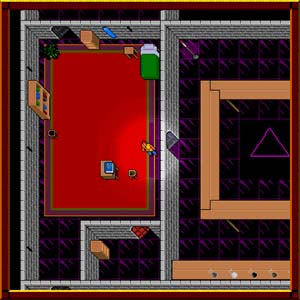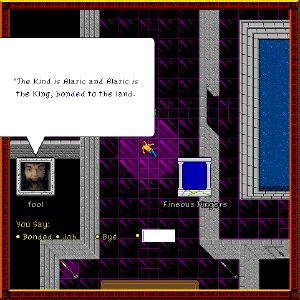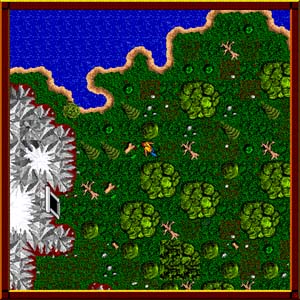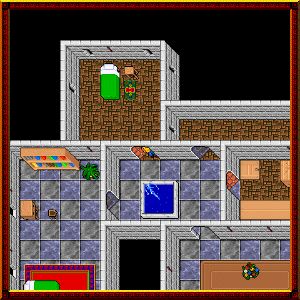This article will take a walk, literally, through some of the features in the Delver engine.

This picture shows a typical view inside a building. You can see the lighting algorithms at work, with the pool of light around the player, as well as the candle in the adjacent room. It also shows the ability of the engine to work with objects larger than a single tile - even though the engine is based on 32x32 tiles, things like the bed and bookcase are larger than that. It also shows the layering - the book is on the desk which is on the rug which is on the floor, for example.

Here is an image of a conversation - in this case between the player and the enigmatic Magpie, the King's Fool. While there have been aesthetic changes between this screenshot and the current version, the important part is that the conversation consists of a combination of keywords, as well as a field where you can type other words. Note that the keyword "Bonded" is pulled from the response that Magpie just gave you and is added to the keyword list.

Not all action takes place indoors - there is also a whole world to explore. Here you see the player having left the mountain stronghold of the LandKing and getting ready to brave the trackless forest between there and civilization.

Here's another indoors shot, this one showing off the way "line of sight" is handled. Basically, if you can see a room, you can see the entire room, and what you can't see is entirely black - it even "reshapes" things like the wall corners so as to not have a corner dangling into space. If you walk to the windows in the room to the north, you'd also be able to see outside.

In this screenshot, we enter a small house at twilight - things are already beginning to get dark - good thing we've got a light source. This shot shows an example of how the engine handles the roof of a building - when you enter the building, the roof goes away. You can see the roofs on adjacent buildings.
These images have shown some of the capabilities of the engine, but you need to experience it first hand to truly appreciate it. The engine doesn't use artwork just to look like artwork - for example, the bed is a "real" bed, not just something that looks like a bed. If you use it, you can take a nap. You can open the dressers, light or blow out the candles, sit in chairs, etc... The goal is to make the environment as interactive as possible.
And of course there is music - in the words of one of our testers "hearing the music as I started up for the first time gave me the shivers." There is even stereo sound - as you walk past a fountain, the gurgling sound pans between your speakers.
Of course, this might be fun all by itself (and at times it is), but there's an epic story going on here. From simple events like a kidnapping or trying to find the cure for a mysterious plague, exploring caves and ancient ruins, to political intrigue, and even mystical alien powers and mythical secrets, the Cythera scenario has it all.
But wait, there's more. Not only will there be a rich and powerful graphical engine and epic story, the interface is as great as the other two parts. It is first and foremost a Macintosh interface, enhanced to provide an emersive experience. Reading a book doesn't just pop up a modal dialog with the text of the book, it brings up a window that looks like a book with the text in it. You don't have to wade through a maze of modal dialogs to move an item from one character to another - just open up the character windows and drag the item from one to another. Even during conversations (the most modal part of the game) you can still look at your Delver Journal to see if there is a note you made that might be useful.
One of the driving goals of the Delver engine was to raise the bar for the Macintosh role playing market. We want games that take full advantage of both the Macintosh experience as well the power of the platform. The Delver engine was designed to do this. Consider the bar raised. But of course, would you expect anything less from Ambrosia? ;)